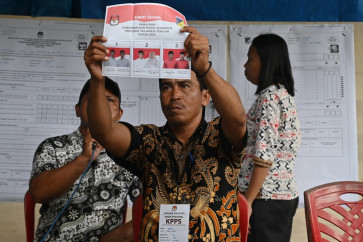Popular Reads
Top Results
Can't find what you're looking for?
View all search resultsPopular Reads
Top Results
Can't find what you're looking for?
View all search resultsContest highlights beauty of Siamese fighting fish
Abdul Mutholib was carefully observing a yellow plakat (shortfin single tail) Siamese fighting fish inside a 225 square centimeter aquarium while occasionally pointing his pen at the animal gliding inside
Change text size
Gift Premium Articles
to Anyone
A
bdul Mutholib was carefully observing a yellow plakat (shortfin single tail) Siamese fighting fish inside a 225 square centimeter aquarium while occasionally pointing his pen at the animal gliding inside.
He was among nine judges assessing hundreds of ikan cupang (betta fish) competing in a beauty pageant of sorts recently held on a basketball field at the Garuda housing complex in Cipondoh, Tangerang, Banten.
Around 417 tanks filled with various species of betta fish went through six hours of assessments to win 34 categories in the contest.
With vibrant colors, long fins and tails flowing around like an underwater ball gown, these betta fish are the pride and joy of their collectors, ranging from children to adults.
The Siamese fighting fish, in accordance with its name, is known for its aggressiveness, a trait that has prompted collectors to keep them and have them fight each other.
The practice has triggered controversy, but people in the community continue to place bets on betta fish fighting.
Other collectors, however, prefer to focus on the fish’s beauty. One of the participants of the recent contest in Cipondoh, Wing Wiryawan, a post-graduate academic at a university in Depok, West Java, said he had been collecting giant betta fish for four years.
The Giant betta fish can grow to more than 4 cm in length.
“[Collecting Giant betta fish is] my hobby,” he told The Jakarta Post at the sidelines of the contest.
He enjoyed participating in contests, which he said was a refreshing venture from his routine.
As part of his hobby, Wiryawan said he spent around Rp 2 million (US$133.75) a month for water, food and medicine for his collection of 40 Giant betta fish.
“Betta fish can be a potential business, too, for a collector like me. Sometimes I earn money from selling them. But I prefer to pursue [collecting] as a hobby, instead,” he said.
For fellow collector Sigit, 31, a Tangerang resident who works as a contract employee, said he participated in these competitions to boost sales of his betta fish.
“[It’s] not bad to get some extra income,” he told the Post.
Sigit said the price of a winning betta fish could be double, sometimes triple that of a regular betta fish.
“For instance, if a baby [betta fish] won a contest, its price could reach Rp 300,000 from Rp 100,000,” he said.
Teddy Permana, chairman of the Banten Ornamental Fish Association who chairs the contest, expressed his agreement, adding that the betta fish was relatively easy to take care of and would not need an aerator and expensive food — making it a popular pet among fish lovers.
Teddy emphasized that the contest aimed at encouraging collectors to become breeders, saying that the world demand for this colorful fish was tremendous.
“The world demand is from 5 [million] up to 7 million fish per month. Meanwhile, Indonesia’s monthly supply us only around 100,000 fish,” he said, adding that the country has exported mostly to Singapore or to European countries such as Germany, Belgium and Switzerland.
However, he said Indonesia was lagging behind its neighboring countries in terms of export, in particular Thailand, Malaysia and Singapore.
Due to the country’s tropical climate and the abundant availability of natural feed for the fish, such mosquito larvae, bloodworms and water fleas, Indonesia could lead the betta fish supply worldwide, Teddy said.
“Hopefully, people would be interested in breeding betta fish as well.” (sau)










